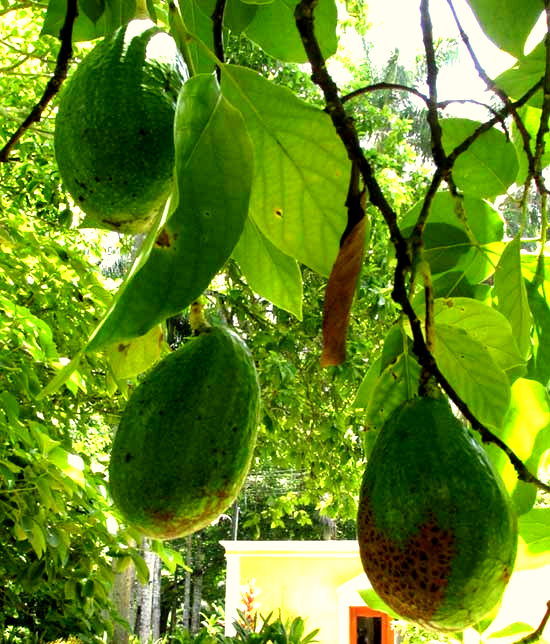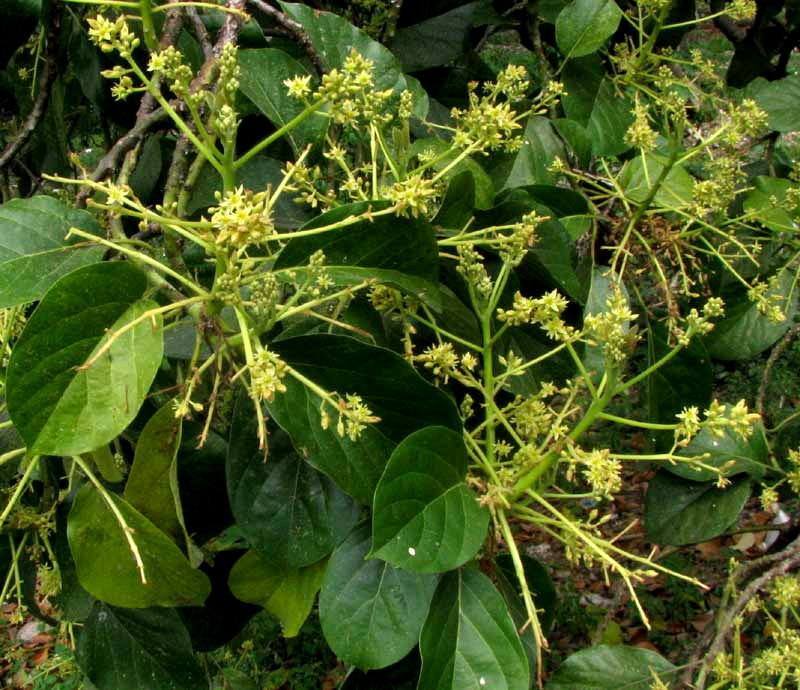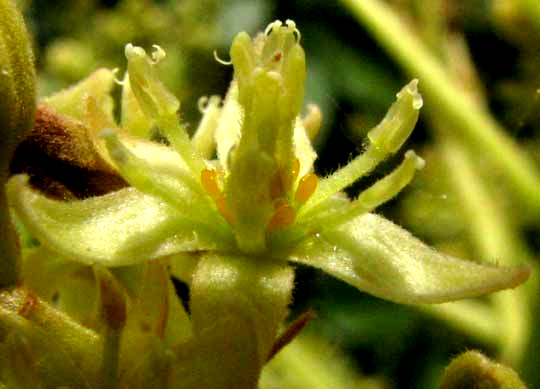Excerpts from Jim Conrad's
Naturalist Newsletter
from the August 14, 2016 Newsletter issued from Hacienda Chichen Resort beside Chichén Itzá Ruins; limestone bedrock; elevation ~39m (~128ft), N20.675°, W88.569°; central Yucatán state, MÉXICO
TYPICAL AVOCADOS
Nowadays at the Hacienda, typical avocado fruits dangle from limbs, just beginning to ripen, shown below:

from the September 12, 2010 Newsletter issued from Hacienda Chichen Resort beside Chichén Itzá Ruins, central Yucatán, MÉXICO
REALLY BIG AVOCADOS
That same day I saw the really big avocado on a streetside tree shown below:

I could only see three fruits, and all were so high up I couldn't measure them. However, an Avocado tree leaf is about four inches long (10 cm) and the fruit seems about twice as long as an average leaf, so that avocado fruit must be around eight inches long, which qualifies it as a very big avocado.
I thought that maybe I'd found a rare cultivar only grown in Maya territory, but my Maya friends say that it's nothing special, just one of several avocado cultivars planted everywhere in the tropics. Some cultivars produce remarkably large fruits. If I had to guess which cultivar is shown above, by matching pictures on the Internet, I'd say that it's the "Fuerte" cultiver, which is a fairly commonly grown type.
Avocados are native Mexican plants, and Mexico is by far the world's greatest exporter of them. You might enjoy reading the history section of Wikipedia's Avocado page.
If you have an Avocado tree and want to try to identify which cultivar it is, a helpful piece of information is that among Avocados there are two flowering types: "A" and "B". "A" cultivar flowers open as female on the morning of the first day and close in late morning or early afternoon. Then they open as male in the afternoon of the second day. "B" varieties open as female on the afternoon of the first day, close in late afternoon and reopen as male the following morning. Once you know whether you have an "A" or "B" type, you can rule out about half the cultivars.
from the March 4, 2012 Newsletter issued from Hacienda Chichen Resort beside Chichén Itzá Ruins, central Yucatán, MÉXICO
AVOCADO TREES FLOWERING
Along the backstreets of Dzitas, a little Maya town maybe 20 minutes by car north of Pisté, branch tips of Avocado trees are loaded with diffuse, basketball-size panicles of small, yellowish flowers as shown below:

Up close, the blossoms reveal several interesting features, as seen below:

Avocado trees, PERSEA AMERICANA, are native tropical-American members of the Laurel Family, the Lauraceae. The above picture shows several features common to flowers in that family. (Other Laurel Family members Northerners might be familiar with include Sassafras, Spicebush and the Laurel itself.)
Flowers in the Laurel Family normally are yellow or greenish, with no corollas or petals, which is the case with this flower. In the picture, the fuzzy, petal-like things spreading from the flower's center are calyx segments adapted to visually attract pollinators, a job more commonly handled by a flower's corolla. The calyx has six lobes, but notice how the lobes overlap; at the left, one lobe practically lies atop another. This overlapping of sepals also is a Laurel Family characteristic.
In the picture, the slender thing with a bulging top pointing toward the picture's top, right corner is a stamen. In the Laurel Family, stamens are arranged in three or four "whorls" -- an outer ring of them, an inner ring, and one or two rings inside those. In the picture at least two stamen whorls are recognizable. Notice the orange things at the base of some of the stamens. Those are "staminodia," or modified stamens, representing one of the whorls. I'm not sure what the staminodia do here; maybe their bright color helps attract pollinator toward the flower's center.
Also notice the curious flap-like items atop each stamen's anther -- the anther being the baglike thing in which pollen is produced and later released. In the Laurel Family, anthers lose their pollen through holes left by uplifting "valves." Those flap-like things atop the anthers are uplifted valves, and this curious construction also is a Laurel Family curiosity.